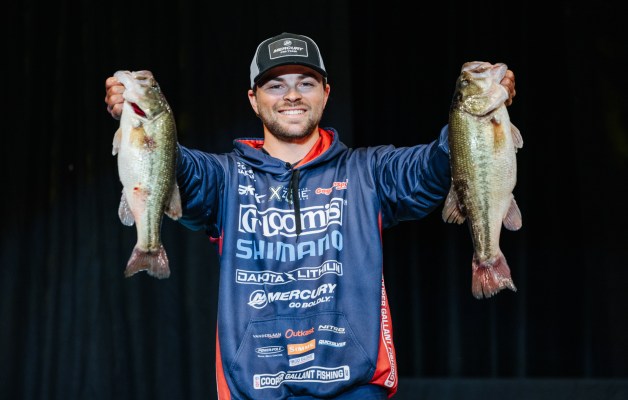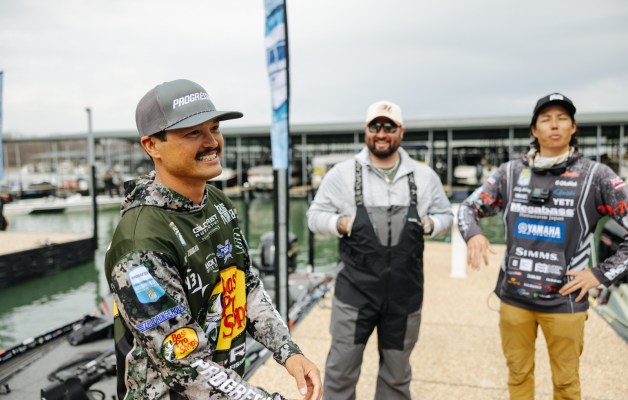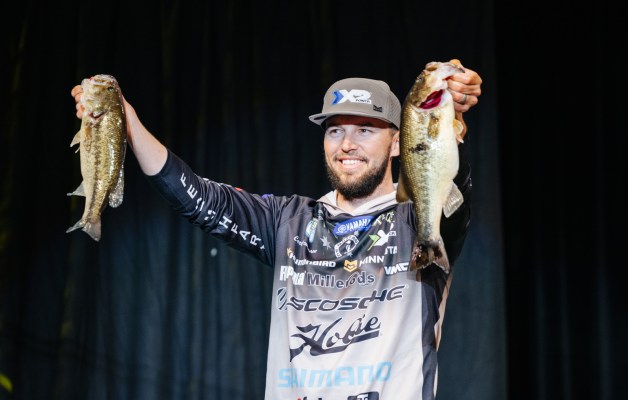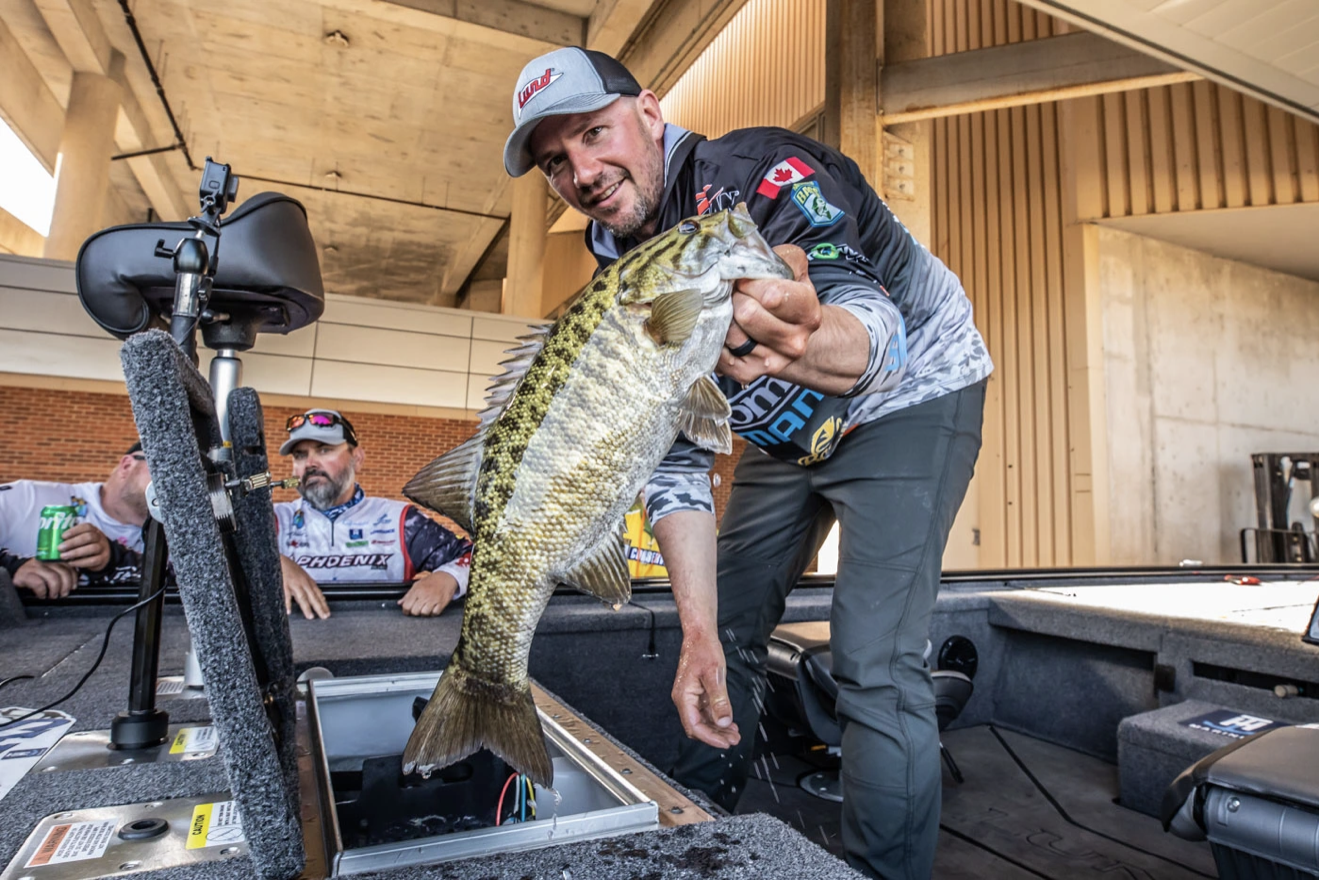
Ladson, S.C. – Thirteen hundred miles north of the Tennessee River; twenty years before Jeff Gustafson won the recent Bassmaster Classic— long before live sonar screens rewrote the rules of angling engagement— hanging a minnow was already boating tournament-winning bass in a big way.
Up ’til then, Gussy’s Classic winning presentation was widely viewed as a niche technique—something that only worked up north for suspended or deepwater smallmouth bass. Perhaps most anglers still view moping—vertically hover-jigging with buoyant Jerk ShadZ™ superplastics—as super specialized, similar to the way anglers once regarded offshore bass patterns, in general.
Interestingly, a week after Gussy won the 2023 Classic, Aric Szambelan of Missouri State University finished just 3 ounces shy of winning the Bassmaster College Series qualifier at Cherokee Lake, Tennessee—you guessed it, moping a ¼-ounce jig and Scented Jerk ShadZ.
“The truth is, I caught fish with this same bait and method in at least half of last year’s Bassmaster Elite tournaments,” divulges Gustafson, who also tapped the technique to win the 2021 Bassmaster Elite event at the Tennessee River. The Keewatin, Ontario bass pro says he’s now earned over half a million dollars with a jig and Z-Man Scented Jerk ShadZ— the prized presentation he calls his best bait of all time. He’s won or nearly won numerous other derbies on Rainy Lake and Lake of the Woods, Ontario, all the way to Lake Champlain, New York, dating back almost two decades.
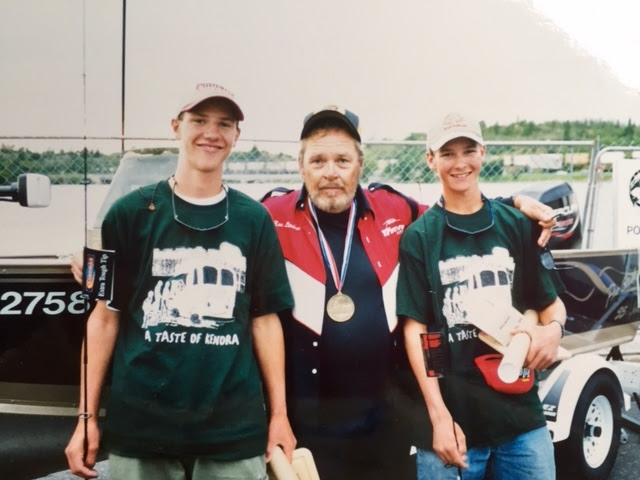
“Back in the early 2000s, Hall of Fame anglers Jimmy and Bill Lindner won back-to-back Fort Francis Canadian Bass Championships, targeting suspended Rainy Lake smallmouths,” recalls Gustafson. Unquestionably, the Lindners pioneered the original moping technique, discovering untouched populations of suspended smallmouths in the process.
“At this point, given the success I’ve had moping on Canadian lakes all the way to Georgia and even Texas, I’d have to say it probably works in more places than it doesn’t,” he suggests. “Late spring, summer and fall . . . anytime you’ve got largemouths, smallmouths or spotted bass feeding on suspended smelt, ciscoes, alewives, shad or herring, or using structure in 15 to 30 feet, moping can unlock some crazy bites. In fact, many times, moping a jig and Jerk ShadZ is way more effective than a dropshot.”
In other words, anyone who calls Gussy’s method a niche pattern might first want to try it on their local lake.
History of ‘Hanging a Minnow’
As Gustafson submits, the original moping method emerged in the early 2000s, inspired by ultra-competitive Canadian contests like the Fort Francis Canadian Bass Championship. Gussy, who won the event in 2013 and 2014, says the Canadian Bass Championship, alongside the Kenora Bass International on Lake of the Woods, comprise two of the more competitive, coveted bass trophies in North America. Each event swiftly fills 130-boat fields, attracting a collection of exceptional angling talent from across the continent.
“The year Jim and Bill Lindner won the first of their back-to-back Championships, we heard a lot of buzz about this new technique, fishing for suspended postspawn smallmouths,” suggests Gustafson, referring to the 2003 and 2004 Rainy Lake bass derbies.
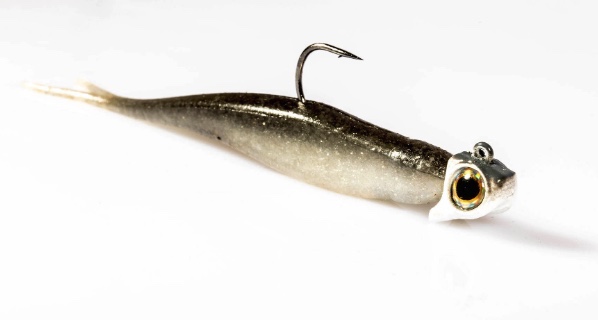
“Around that same time, we knew Alex Keszler was fishing vertically over deepwater in his tiller boat, catching big smallmouths, late spring through fall. But back at the dock, because everyone was super secretive, and hid their rods in storage, you didn’t know what baits these guys were packing.
“Eventually, word got out that the Lindners and others were using fluke style softbaits rigged on 3/8-ounce jigheads with 90-degree eyelets,” recollects Gussy. “The 90-degree angle deal is key because it helps position the jighook and bait’s tail nice and horizontal, not vertical or tilted down. (More on the horizontal advantage, momentarily.)
“At first, we were using any type of 3- to 5-inch fluke style bait we could find. But it wasn’t long before Keszler and other anglers discovered a new style of buoyant superplastic that hovered horizontal in the water, matching the natural swimming posture of suspended baitfish. Eventually, we found out guys like Keszler and Ted Stewner were actually sewing their ElaZtech baits to jigheads to create a permanent lure, preventing the bait from being pulled down the hook. Now, of course, a drop of Loctite Gel Control accomplishes the same advantage.
“Early on, Z-Man was making the baits for another company, which were exceptionally soft and just crazy durable. Like, you could fish all day with one bait—catching up to 100 bass— if you wanted. A few years later, Z-Man started making the Scented Jerk ShadZ under their own label, which quickly became the de facto moping bait among most of the serious tournament anglers.”
Suspended Smallmouth Discovery
Leading up to the 2003 Rainy Lake championship, Hall of Fame anglers James and Bill Lindner had been tracking postspawn smallmouth bass, as big females filtered from spawning bays back toward the main lake. “What we discovered was that as the fish flushed out of the bays, they didn’t swim deeper in the water column, as we suspected they would,” recalls James Lindner. “We were following individual bass with an Aqua-Vu camera— catching them on various shallow running lures—as they moved farther and farther out into main lake toward mazes of rock humps. We also found that the biggest bass were the first ones to leave spawning areas and swim offshore.
“We’d start on these points and work out into the big lake. Using the camera, we observed bass all over the ends of these structures. Some days, within a few hours as the water warmed, all the smallmouths would move straight off these rock points and suspend over 75 feet of water.”
“In the past, suspended smallmouths had always been to be difficult to catch,” explains Lindner. “But when we began to simply hover a jig and soft minnow-shaped bait dead-still below the boat, we’d get bit almost nonstop.
“I remember early in that 2003 tourney, I hooked a good one when sort of shockingly, Willy (Bill) popped another 3-1/2-pounder, four feet down, right in the boat’s shadow. I unhooked my bass, dropped down and caught another big smallmouth, again, right beneath our boat. Happened so fast it was like crappie fishing; within minutes we had a pile of big smallmouths flapping around our feet before we could get ’em all in the livewell.
“The weird thing was, all the fish were 5 feet down over 20, 40 and eventually, 75 feet of water as the days progressed. We went to six more spots like this—where a spawning bay opened toward the main lake—and caught fish on every one of them. I believe the fish weren’t willing to shift deeper because they wanted to be in that warmer water near the surface, rather than the cooler water past the thermocline. In many cases, the fish were so high in the water that you’d never see them on electronics.”
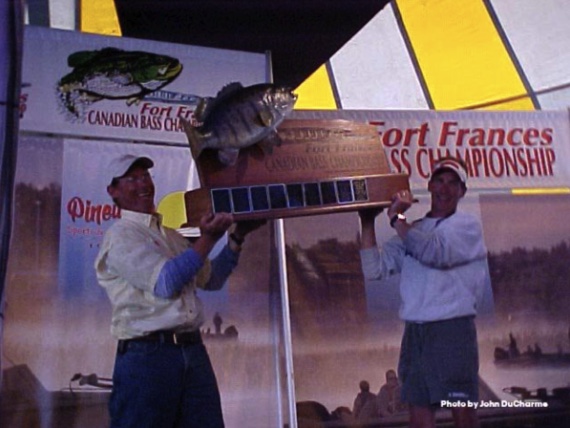
Moping ‘Em Up!
Lindner notes that during the same tournament in 2004, the bass were deeper—as much as 15 feet down over 35 feet of water. The brothers boated dozens of football smallmouth bass as well as giant pike and walleyes. “At one point in the tournament that year, Willy caught a horse of a walleye—probably a 12-pounder. He’s standing there admiring the fish. And I’m urging him to get the walleye back so we can get back to the bass and try to win.” After placing 1st in 2003 and 2004, Lindner also led the first two days of the 2005 event, until a fog delay rolled in and stalled the bite.
During one of those tournament days, while observing his sons’ motionless forms from his own boat, Ron Lindner bellowed, in his familiar Chicagoland intonation, “Looks like you guys are just moping around over there!” Rods frozen in hands, the brothers resembled statues, heads downturned in apparent boredom. Later, Gussy recalls Lindner, one of his fishing mentors, saying “‘You guys really moped ’em up out d’ere!”
Still in high school at the time, Gussy notes that Ron’s famous brother Al “didn’t like moping because his type-A personality wouldn’t allow him to fish that slow,” he laughs. “When I first met Ron in the late 1990s, we hit it off right away. He told me: If you ever beat me, I’ll give you a hundred bucks. Another time, Ron let me pick ten baits from Al’s boxes when I won. That was almost cooler than winning. He’d always call me after tournaments to check in, see what was new. Up ’til his last days, Ron never lost his fascination for new techniques; he always wanted to know what I was up to next.”
Anti-Jigging & Adjustments
James Lindner admits that at first the newly emerging pattern reminded him of ice fishing. “You just drop the bait down and hold it dead-still. Sometimes, the fish are so shallow, you net ’em on the very first jump.”
Gussy adds: “Something about the way a buoyant Jerk ShadZ on a Smeltinator jighead spirals on the drop that mimics deadfalls of smelt (or other baitfish). In most cases, bass using these deep areas key on easy meals of dying baitfish, tumbling from above. They’re looking up, not down, so it’s counterproductive to drop the bait below the bass or to work the bottom.”
To maximize bites, Gussy stops the bait a foot above bottom or the level of suspended bass. “Just let the Jerk ShadZ’ buoyant nature hover and hold still. Many times, as happened at the Classic, when you first pull into a spot, you might not see a single fish on sonar. But on that first drop, you’ll watch multiple fish—or the whole school— rocket up on a collision course with your bait. If the spot looks right, ideally with some rocks in the area—even if you don’t see bass—the Jerk ShadZ becomes your fish finder.”
On known spots, as fishing pressure intensifies, Gussy often spices the presentation with subtle jigging movements, tricks learned over decades of cat-and-mouse style fishing with sonar, often while ice fishing. In current, Gussy drops the bait into slackwater current behind rocks, occasionally giving bait a little shake to attract attention.
“Usually, there’s very little actual jigging,” he explains. “But if bass approach yet hesitate, I give the bait a slight little quiver. Or you can pull it up and away—make them chase or play keep-away.
“You’ll feel bass bump it, too—doing drive-bys, like they’re trying to stun the bait—where they strike with their mouths closed. If they do that, I drop back down and give it a quick little quiver, mimicking an injured baitfish.”
He further notes that a calm surface can make bass tough to trigger. “A lot of first timers with this technique fail because they aren’t wired to just hold their rod and bait dead-still. Or they won’t keep it off bottom. Or, they don’t have their bait perfectly aligned on the jighead, which causes it to spin and appear unnatural.
“It’s why I pre-rig a half dozen jig-Jerk ShadZ combos the night before tournament days. Permanently secure each bait with a drop of superglue and you’ll rarely need to readjust it on the hook. Just one of these bad boys can hold up to dozens of bass and well over a full day’s fishing. Only reason I switch baits is to refresh the scent (Jerk ShadZ come pre-marinated with Pro Cure gel) or to try a new color.”
To bolster the bait’s a natural horizontal posture, Gustafson frequently repositions his knot, pinning it topside. He says a loop knot is counterproductive because it allows the jig to tilt and pivot away from 90-degrees. “My buddies and I have messed with a bunch of different knots, and often use a San Diego Jam (aka reverse clinch knot), which cinches up super tight to the eyelet with fluorocarbon.” Gussy rigs with 10-lb test Power Pro mainline and a 10-lb pound fluorocarbon leader.

Final Refinements
At the Bassmaster Classic, as bass got spooky and reacted to boat presence and fishing pressure, Gussy found it necessary to pitch his bait away from the boat before letting it descend and swing, rather than dropping straight below the trolling motor. “I always prefer to sit right over the fish, if possible. But on the Tennessee River, I eventually had to pitch the jig 10 to 20 feet in front of the trolling motor and let it swing over the top of the fish. Usually, a bit of separation triggers extra bites. Regardless, that first drop on a fresh spot is always key. After you hook a few fish, they can turn wise. If you see ’em reject you on sonar a few times, it might be time to shift locations.”
Another key adjustment involves downsizing bait selection. “Bass in these areas can be hyper-focused on specific bait species, colors and sizes. “At the Classic, I occasionally switched to a slightly smaller StreakZ 3.75, otherwise identical to the 4-inch Jerk ShadZ.” The Smelt pattern produced most of his bites, while Shiner and Bad Shad’ serve as solid back-ups (Gussy’s also working on two fresh colors, to be released soon.)
A perfect match for deepwater structure, suspended bass and interactive sonar style fishing, hanging horizontal with a soft superplastic minnow consistently coughs up dozens of bass per day. “With optimal conditions and the right baits, catching 50 to 60 bass a day is totally doable,” Gussy suggests. “The combination of bait buoyancy and durability are critical, total difference makers. I’ve been fishing that same Jerk ShadZ bait for so many years now—way before I even signed a sponsor deal,” he winks.
Long before locals moped minnows south of the border, the legendary Lindners were already starting something big. Indeed, as offshore, sonar-interactive methods continue to expand, Gussy will one day be known as the master of moping . . . but only in the best bass-catching sense of the word.

